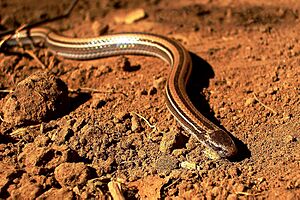Madagascar Burrowing Snake facts for kids
Quick facts for kids Madagascar Burrowing Snake |
|
|---|---|
 |
|
| Conservation status | |
| Scientific classification | |
| Genus: |
Pararhadinaea
|
| Species: |
melanogaster
|
The Madagascar Burrowing Snake (scientific name: Pararhadinaea melanogaster) is a special kind of snake found only on the island of Madagascar. It's the only species in its group, called Pararhadinaea. This small, secretive snake belongs to the Pseudoxyrhophiidae family. It was first described by Oskar Boettger in 1898.
Contents
About the Madagascar Burrowing Snake
This snake is quite small, usually less than 30 centimeters (about 12 inches) long. It has a pale golden-brown body with dark-brown and cream stripes running along its length. The scales on its belly are very dark, almost black. Its smooth scales can even shimmer with a beautiful green-blue iridescence when the light hits them just right!
Scientists have also identified one special type, or subspecies, of this snake called P. melanogaster marojejyensis.
Where It Lives: Geographic Range
The Madagascar Burrowing Snake is found only on the island of Madagascar. It lives in the northern parts of the island. The first time this snake was officially found was in a place called Nosy Be. The only known example of the marojejyensis subspecies was found in the Marojejy National Park.
Its Home: Forest Habitats
This snake has only been found living in forests. It can live in both the dry forests and the wetter lowland forests of Madagascar. Some of the places where it has been seen include Nosy Be, Ankarana Special Reserve, and the Daraina Conservation Site. It has also been found in small forest areas near a village called Tsarakibany.
Life and Habits of the Snake
Almost nothing is known about how this snake behaves. It is very shy and seems to spend most of its day hidden. You might find it hiding among fallen leaves, under logs, or even underground.
What It Eats: Feeding Habits
Scientists believe that the Madagascar Burrowing Snake probably eats small invertebrates, which are tiny creatures without backbones, like worms or insects.
How It Reproduces: Life Cycle
Not much is known about how these snakes have babies. However, like many snakes, it is thought that they lay eggs.
Protecting the Madagascar Burrowing Snake
The IUCN (International Union for Conservation of Nature) has listed the Madagascar Burrowing Snake as a Vulnerable species on its IUCN Red List of Threatened Species. This means it needs our help!
It's considered vulnerable because:
- It lives in a small area, less than 6,500 square kilometers.
- It has only been found in seven different places.
- Its forest home is shrinking and getting damaged. This is mainly because people are clearing forests to make farms.
This snake is also considered very rare. Since it was first discovered, only nine of these snakes have ever been officially recorded by scientists. Protecting its forest home is very important for its survival.


